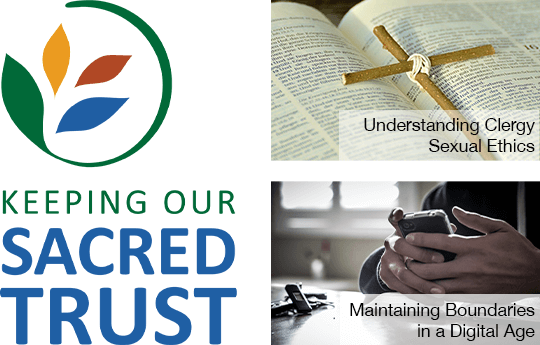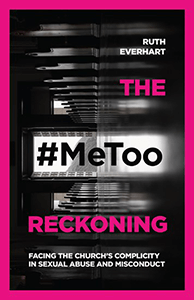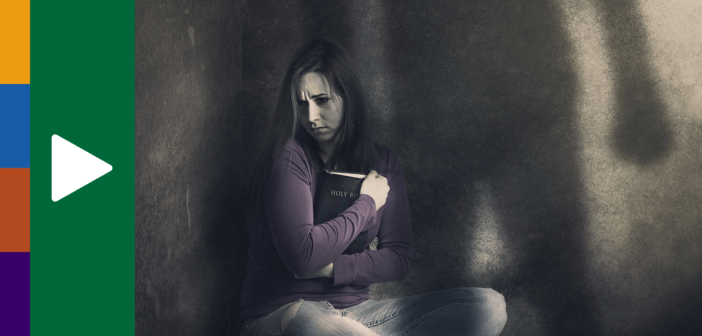
How can the church confront its complicity in sexual abuse and misconduct? Ruth Everhart says churches must restore justice by creating safe spaces for victims to share their stories while committing to appropriate measures to both prevent and respond to incidents of misconduct and abuse.
Listen on Apple Podcasts | YouTube Music | Spotify
Watch on YouTube

- Transcript — Click or Tap to Read
-
Announcer: Leading Ideas Talks is brought to you by the Lewis Center for Church Leadership of Wesley Theological Seminary in Washington, DC. Subscribe free to our weekly e-newsletter, Leading Ideas, at churchleadership.com/leadingideas.
Protect your congregation and your ministry with online sexual ethics training for pastors. The Lewis Center’s Keeping Our Sacred Trust boundary training program offers two courses to help prevent clergy sexual misconduct: Understanding Clergy Sexual Ethics and Maintaining Boundaries in a Digital Age. Both courses are confidential, ecumenical, and refreshed for 2023. Each course is $49 and includes .5 CEU credits. Learn more and enroll at lewisonlinelearning.org.
How can the church confront its complicity in sexual abuse and misconduct? Ruth Everhart says churches must restore justice by creating safe spaces for victims to share their stories while committing to appropriate measures to both prevent and respond to incidents of misconduct and abuse.
Ann Michel: Welcome to Leading Ideas Talks Podcast. My name is Ann Michel. I’m a senior consultant with the Lewis Center for Church Leadership and also co-editor of Leading Ideas e-newsletter. I’m your host for this episode of Leading Ideas Talks. I am so honored today to be speaking with Ruth Everhart, who is a Presbyterian pastor, an author, a Christian feminist, and one of the leading voices on the need to address issues of sexual abuse in the church. She’s the author of several books and, most recently, The #MeToo Reckoning: Facing the Church’s Complicity in Sexual Abuse and Misconduct. And that’s what we’re going to be talking about in our time together today. Welcome, Ruth. Thanks for being with us.
Ruth Everhart: Thanks, Ann. So glad to be here.
Ann Michel: I wanted to begin by acknowledging that this subject is so deeply personal for so many people, as it is for you. Since many of our listeners may not know your story, if you don’t mind, I will share that I learned in reading your book that you were raped at gunpoint as a college student, and then in your first pastorate, you were groomed and sexually abused by the senior pastor of the church you were serving. And then you really suffered the indignity of having your complaints trivialized and rationalized away by the people that were responsible in the church. And it’s really a harrowing, painful story to read. But you believe it’s critical for the church to listen to the stories of victims and survivors — stories that a lot of us would prefer really not to have to hear. So, I wanted to begin by asking, why is telling stories so important to the #MeToo reckoning?
Ruth Everhart: Well, Ann, thanks for acknowledging how really deeply personal the subject is because it is that to me and just everybody who’s involved in the subject of sexual abuse in churches. And I think that the reason that stories matter so much is that’s how we get at truth. So often, the person who tells the story is the person who has the power, and that means that usually the stories are told by the person with power, so to center the story on victims and survivors completely changes the narrative and changes, then, the lens of how we look at the subject.
I think that was the great revelation of the #MeToo movement when it burst on the scene. That’s what framed a different kind of a narrative, and it allowed women’s voices or often men’s voices, too, but the voices of victims and survivors to be heard. So, it’s absolutely essential to tell stories. And it’s not incidental that scripture is completely full of stories. If we break it down, it’s a big storybook. To come at it that way — that’s why I had the idea of intertwining the biblical stories with the current stories, to kind of to see how they informed each other.
Ann Michel: I believe in the opening of the book you say that “story is the way that we change our culture, the way that we define our culture, and that we can’t really change things without being willing to tell stories.”
Ruth Everhart: I think that’s true of every justice issue. We don’t really have the eyes to see it until we see it interpreted through somebody’s story. Otherwise, we have this kind of distance from it. And that’s not powerful enough to affect the kind of culture change that’s necessary to deal with a justice issue.
Ann Michel: I want to go back to the point you made briefly about the Bible. I first became acquainted with your work in reading an article that you had published in Christian Century entitled “Women of the Bible Say Me Too.” I think it came out in 2018, right as the #MeToo movement was so much in the news. I thought that was such a powerful, powerful article. You lifted up the stories of Tamar and Bathsheba, Dinah, and other biblical women who were victims of sexual violence and abuse. Then, in your book, you do such an artful job of interweaving those biblical stories alongside your own story and the story of other survivors of abuse. And the way that you tell it, these Bible stories became for me such a source of solidarity and spiritual insight. At the same time, it was a reminder to me of how much misogyny and mistreatment of women is in our Scriptures and how often those stories have served to normalize or legitimize mistreatment of women, so I wanted to ask about how we regard the Bible in this sense. You bring such an enlightened feminist perspective to scripture. And yet not everybody does. And at the working level day to day in our ministries, I’m wondering how we can prevent the Bible from being used as a cudgel and instead allow it to be used in a positive way with regard to this issue.
Ruth Everhart: Well, we can only control how we use the Bible. I think we can’t control how other people do it. But what we can do is demonstrate a different kind of use of scripture. And I do think that with the changes since the pandemic shutdowns, you know every preacher is now a media preacher, right? We’re on livestream or on YouTube, and there is the possibility of disseminating a message more widely and to be really conscious of how it is you’re using the Bible and to let yourself be informed by other kinds of approaches, to be really contextual in your approach, to be informed by liberation theology, queer theology, feminist theology, womanist theology, you know, to have that lens.
Then, be self-evident about it as you work with scripture to really plunge into scripture in a sermon or in a Bible study and to do that just as transparently as possible — to kind of wrestle with a text on the page or in the sermon. Then, when you hear people use the Bible as a cudgel, can we call it out the same way you wouldn’t stand for listening to someone tell a racist joke or make a misogynistic slur? You can say “No. It’s not really what the Bible is doing. You know, I read the Bible differently than that.” But that requires being comfortable in the Scriptures. I do understand that we don’t want to weaponize the Scriptures, so we tend to back away from that kind of engagement. And because we’ve become so polarized in our country and we’ve got these two alternative worlds going, it’s challenging. We can only do our part and call out what we see as best we can.
Ann Michel: Thank you for that response because I think that’s exactly what I was getting at, about how we may see the Scriptures from a certain light in how we think about these issues, and others are seeing them in a different way. I think that does pose a challenge. Something else about your book really jumped out to me. Your story and some of the other stories that you highlight really helped me see how terribly unprepared local congregations are to deal with issues of sexual abuse or harassment when they arise, for all kinds of reasons. But the one that really stood out to me was that, in the stories you told, it was often volunteer leaders, officers in the church, people like you and me, who are church members, who maybe hold a committee position, maybe they’re on the personnel committee or something like that, and they are kind of the front line in having to deal with a problem or complaints or suspicion. And they are often really ill-prepared to do this and have conflicting interests. It just seemed to highlight such a serious issue, so I wonder how we can do a better job of helping these frontline congregational leaders, who often are volunteers, do a better job.
Ruth Everhart: That’s right. Because we’re really investing professional-level work in people who are essentially amateurs, you know, well-meaning people, but they are not prepared for what they have to deal with when it’s something as dynamite a package as sexual harassment and abuse. You know, I can have sympathy for the fact that they are not prepared for what they have to manage. The only way to do that is to really be intentional about equipping them at a time when the world isn’t burning, at a time when you have the moment, which can be hard to find, to set up a time to have a training opportunity for the people that would be impacted by this. I mean you don’t want to wait until there’s been an accusation to tell people how to respond.
You want to get ahead of that. You want to have this opportunity to talk about how this should be approached, to learn the basics of trauma-informed care. What does it mean to work on that vocabulary? To talk about centering the victim and not the perpetrator. To talk about the role of using the legal system — or the justice system if you’re in a church. Is that ever permissible? I mean there’s so many ways that you can talk about this in different ways: in adult education, in leadership training. I’m a Presbyterian and my presbytery, which is National Capital Presbytery, is a little more forward thinking. We’ve been required to do something called boundary training for a couple of decades. And we have to renew it every three years. They’ve gotten to the point now where it’s an online course, and I think that’s so great, so there are opportunities out there to just have people do things online, to have conversations with your leadership, talk about it in adult ed. You just have to come at it from different ways so that people are more equipped.
Ann Michel: I’m certainly aware of the different boundary trainings. In fact, the Lewis Center has some programs, as well. But they are aimed at clergy. We haven’t really ever thought about what would be involved in training some of the lay persons or other congregational leaders that might be in positions of responsibility with regard to responding to sexual abuse as opposed to preventing it. You talk about there being two issues — the issue of preventing sexual misconduct and then the issue of responding to it. Both are within the purview of the local congregation, right? Do you think things are getting better? I was aware, as I was reading your stories, that some of it was describing things that had happened some time ago. Obviously there’s been a lot of concern and publicity in recent years. Do you feel that things are getting better?
Ruth Everhart: Well, I think that in terms of prevention, it’s become really normal for churches to have some kind of a safer church policy that protects children and youth. And I mean that’s normative and that’s wonderful. We need to be at that place where we know safeguards. In terms of responding to abuse, what happens sometimes is that allegations like mine are from the past. That’s difficult because you are bringing a more contemporary lens to something that may have happened a long time ago.
This happens with sexual abuse stories all the time. People bring up allegations of things that happened a while ago. And churches are becoming a little more adapt at listening to that. Some of them are actually lifting the statute of limitations, and so on, just like some of our legal systems are, and that’s really important. I do see a few churches that have moved much more quickly to using the legal system — there was this temptation, I think, to view any kind of sexual misbehavior as “sin” rather than as “crime” — and to see it as both, to say, no, this is a crime that needs to be prosecuted in a court of law and [to see]that a court of law can be a tool that churches use. It’s also a sin that has to be dealt with, but that can’t overreach the whole experience because what happens is, if you put it in that category of sin — and we see this happening in some of the Southern Baptist Churches, in some of the stories that continue to come out of there — people can make a public confession, and can receive a standing ovation for having said that, without following those next steps of accountability and punishment and restitution.
So, I would love to say that things are getting better. And I do think they are, incrementally. And it’s a big topic and it covers from the Roman Catholic Church to … I mean I mainly focus on the mainline Protestant churches because that’s my world.
 Protect your congregation and your ministry with online sexual ethics training for pastors. The Lewis Center’s Keeping Our Sacred Trust boundary training program offers two online courses to help prevent clergy sexual misconduct: Understanding Clergy Sexual Ethics and Maintaining Boundaries in a Digital Age. Both courses are confidential, ecumenical, and refreshed for 2023. Each course is $49 and includes .5 CEU credits. Learn more and enroll at lewisonlinelearning.org.
Protect your congregation and your ministry with online sexual ethics training for pastors. The Lewis Center’s Keeping Our Sacred Trust boundary training program offers two online courses to help prevent clergy sexual misconduct: Understanding Clergy Sexual Ethics and Maintaining Boundaries in a Digital Age. Both courses are confidential, ecumenical, and refreshed for 2023. Each course is $49 and includes .5 CEU credits. Learn more and enroll at lewisonlinelearning.org.
Ann Michel: I think another thing your book really helped me focus on is how many pressures within a local congregation really push against wanting to hear someone’s story, particularly if it’s something that’s happened within the congregation. You know, congregations are so poor, I think, at dealing with any kind of conflict or sensitive issue. And it’s so easy for people to want to assume the best of their leaders, to not imagine that something bad could happen within the community of faith that they love — you know, denialism, just wanting to look the other way. I mean it’s a toxic brew. It just really helped me see it that way.
At one point in the book, you wrote that “confidentiality can become complicity.” And that really stood out to me. And I know that’s probably just a huge, huge subject that we don’t have time to get into in great depth today. But I did want to ask you to speak to it briefly because I think that the cloak of secrecy and confidentiality that these things so often get wrapped in can allow problems to remain hidden or ignored. I wonder how we can think about a balance between the level of confidentiality and the need for truth telling and accountability in these matters.
Ruth Everhart: One of the stories I tell was from a church, a rather large church, where I was an associate pastor, kind of way down the totem pole. And there had been abuse within the youth program. The lens that I take on that story is from the point of view of my good friend Ginny, who let me use her real name. We spent hours in interviews as she told me the story from her point of view because she had been one of the people who protected the abuser.
I felt it was so important to include her point of view because I wanted to communicate that it’s understandable when people get on the wrong side of this, not because they’re evil people or because they’re trying to cover something up, but usually it’s the people who value clergy and value their role within the congregation that might be the most likely to protect them even when they have been abusive. I did want to include Ginny’s story in that, and it did cause me to think a lot about this very subject. What’s the difference between confidentiality and secrecy? When is privacy appropriate and when has it become twisted? And I think that the thing to ask is, when we weaponize privacy, who is it that’s suffering and who are we protecting? If our concerns about not telling a story are to protect the person who is at fault, well, that should make us pause, right?
But it’s not so easy because our culture has a long history of trying to protect victims. I think about when I was raped at gunpoint when I was in my senior year of college, and I was only 20 years old. One of the dynamics — and this happened a long time ago, but I don’t know how different it is now — one of the dynamics was that they were going to protect our names and not reveal who we were. But does that mean that we had done something wrong that we needed to be protected from? So, it’s not an easy subject. You get into who’s at fault, who benefits from being hidden.
I do feel our cultural norms are shifting a little bit about that. I see victims stepping up and claiming their story a lot more quickly and a lot more forthrightly than they used to. And I applaud that because it reinforces that the victim is not to blame. I always say, “Why is it so different than breaking your leg? It’s this really unhappy thing that happened to you, but it doesn’t mean you were at fault. To treat it as if it’s just unspeakable — I think that’s such an important word — it’s unspeakable, to say we cannot talk about this, I just disagree with that wholeheartedly. I mean we have a whole treasure trove of scripture in which these things are not unspeakable. There’s lots of stories about sexual assault in the Bible. And we have a Savior who spoke about things that other people didn’t want him to speak about. I mean, this is why we have books and why you have podcasts. We have institutions and we have sermons to break that open and let the light shine into it.
Ann Michel: In the church I attend, within the last five years we had a clergy person who had to leave the ministry because of misconduct. From the point of view of a parishioner, we were left very clueless about what was happening and why. And I think most people in the congregation still feel that way. I think there were legal considerations that impacted what was said and what wasn’t said publicly. But from the perspective of the congregation’s processing and healing, we really were left in the lurch without a lot of transparency and truth telling. I think it was very, very challenging because I think our denominational leaders really saw the issue through a legal lens. They were much more concerned about making sure they went through the right legal steps and not so concerned about what the congregation was knowing and experiencing.
Ruth Everhart: Oh, it makes me crazy! That’s a common story. And the thing is that they can talk about fiduciary responsibility or being a steward of the institution, [say]they’re doing their job and don’t we live by a different set of rules. The church that I was just talking about, where my friend Ginny was working with the youth ministry and this youth pastor. Well, he was a lay person; he wasn’t actually ordained, which didn’t matter. When the senior pastor told the story in worship, he did so against the advice of the insurers of the congregation. So, it takes a real boldness to step outside that norm. Absolutely. No wonder you were interested in my book.
Ann Michel: The point you made about the perpetrator having been a lay person — I heard you speak recently and took note of one of the things you said. You said that “When we look out on our pews on Sunday mornings, there are people in worship who are both abusers and victims of abuse.” So often, when we think about this issue, at least in the work that we do at the Lewis Center, we tend to think about it in terms of clergy persons and the potential for clergy persons themselves to be perpetrators of abuse or engaging in misconduct. But it’s not just the clergy and it’s not just what happens in the church. Having heard you say this, I wondered: what does that mean in terms of the church’s opportunity and responsibility to lead on these issues?
Ruth Everhart: Yeah. That’s a tough one. I do think that pastors have to almost develop a “Spidey sense” about who out there might be an abuser. I feel like I try to sniff them out. And then I do follow up with one-on-one conversations with people who I think might be at risk.
But there’s another issue that’s even harder to talk about, which is that I don’t know that men have a place to talk about the fact that they have grown up in this culture of misogyny and in toxic masculinity. What were the messages that they got about the way they interact with women? I mean, how many men have done things in their life that they now feel ashamed of? Do they have a story about which they are at least deeply chagrined, where it has at least crossed their mind now that they may have abused their power, that at the time it was not in their awareness, and they’ve had a shift?
We talk about abusers like they’re all at the one end of the spectrum and they’re all predators. There are predators out there, and our churches can be breeding grounds for them and can be invitational to them because of using volunteers and so on, so we try to close those doors. What I’m talking about is kind of the other end of the spectrum, your decent guy who grew up thinking at really gut level that he’s more valuable than any of the women he comes in contact with, which gets translated then in all kinds of ways that become abusive. Can the words of Jesus shift this guy’s paradigm? And how can the church help us as a culture to change? You know my wildest dream is to have a group at a church where men sit around and actually talk about this — not as how they’ve been victimized but how they’ve been victimizers — and to shed the light of Jesus on that. I mean I think that’s maybe the next frontier in this movement.
Ann Michel: I’m so glad you shared that because something else that really stood out to me in reading your work is where you say that sexual abuse is a consequence of patriarchy and that we can’t address it without really addressing patriarchy. And then you also talk about clericalism later in the book, which is another ism that relates to this. Those are the root causes. And it seems like so much of where we’re putting our energy is that we’re doing trainings. We’re putting technical bandages on an adaptive challenge of making church and society more equitable and just and of valuing the women and other people who are victims. And that’s a different kind of work than just sending people to Safe Sanctuaries training.
Ruth Everhart. I think the culture shift is always the hardest work.
Ann Michel: Yeah, it really is, but in the final chapter of your book you focus on some of the things that congregations can do. And what I really appreciate is that some of them are simple things, sort of the low-hanging fruit, but I think some of it is really deeper work around lament and listening and creating safe spaces where people can have these conversations. Can you share some of the things that a local congregation might do to begin to work on some of these deeper issues and create some spaces for that storytelling that is so important?
Ruth Everhart: The low-hanging fruit, as you refer to it, involves sending out signals to people that this is a place where you can talk about difficult things. And so maybe it’s putting a hotline number in a restroom. Maybe it’s having a sermon or a sermon series with #MeToo just so you can put it on your outdoor church sign as a signal that says, “Look, they are talking about that there,” or talking about that during April, which is sexual assault month, and during October, which is the domestic violence month. You kind of capitalize on those cultural moments. And you have an article in your newsletter, a sidebar: “What does grooming look like?” Let’s just talk about that. Just something that goes a little deeper and kind of communicates that this is a place that’s safe to talk about that.
I think the next layer, then, is to create these forums like an adult education class. And there’s the preaching thing. And that was my big thing. That was the Christian Century article that you referred to early in the podcast. The focus of that was really encouraging people to preach on some of these stories in the Bible that we ignore. I felt like I couldn’t write the article and not do it. I have preached all those sermons in a church that decided they didn’t really want me there anymore. I mean there is a cost to doing this work. I’ve paid the costs in many different ways, so I understand why people want to tread cautiously. You know, some people can only tolerate this tiny amount of awareness, and they get very nervous. You know people don’t like to talk about sex in church, and unfortunately sexual abuse gets put in the “sex” bucket instead of the “violence” bucket, right?
Ann Michel: I think that’s so often why the conversation gets shut down in the church and people kind of want to overt their eyes. It’s embarrassing and shameful for them.
Ruth Everhart: Yeah, it’s yucky
Ann Michel: I think, at some point in your book you said, “people need a stout heart and a strong stomach for this work.”
Ruth Everhart: Yes. And you have to constantly frame it as a justice issue and not just as a women’s issue because then it just gets sidelined. To me the most important thing is to feel like you’re not doing it alone, to feel like there are partners out there, which is why I continue to do this work, why I’ve reached out in the written word. I do it because I know there are partners out there listening, and I value them. I value each story. When I sign my book, I sign it “Every story matters” because it does. Every person’s effort to bring justice to a story and to bring the light of Jesus Christ into a place that is dark and painful for someone is super important, so we have to get out of our comfort zone to do that. But that’s what Jesus asks us to do.
Ann Michel: That a wonderful last word. Every story matters. And what a wonderful way to summarize your work as well as the biblical witness on this subject. Thank you, Ruth, it’s been a pleasure to talk to you, and I know so many people will benefit from hearing your perspectives.
Ruth Everhart: Thank you so much, Ann. Pleasure to be here. Thank you.
Announcer: Thank you for joining us for Leading Ideas Talks.
Don’t forget to subscribe to our free weekly e-newsletter, Leading Ideas, to be notified when new episodes are published. Visit churchleadership.com/leadingideas.
 Related Resources
Related Resources
- The #MeToo Reckoning: Facing the Church’s Complicity in Sexual Abuse and Misconduct (IVP, 2020) by Ruth Everhart. Also available at Cokesbury and Amazon.
- The #MeToo Reckoning Workshop, a self-paced, online workshop by Rev. Ruth Everhart and Dr. Eileen Campbell-Reed. Learn more at rutheverhart.com and enroll at eileencampbellreed.org.
- Keeping Our Sacred Trust, online courses on sexual ethics and ethical boundaries in ministry offered by the Lewis Center for Church Leadership
- 3 Actions Churches Should Take in Light of #MeToo by Phill Martin
- 7 Ways Congregations Can Respond to the #MeToo Movement by General Commission On The Status And Role Of Women




